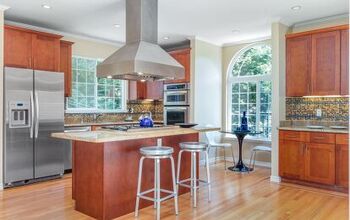Tile Vs. Wood Kitchen Flooring: Which One Is Better?

When it comes to kitchen flooring, you have tens of options, including hardwood, natural stone, ceramic tile, laminate, vinyl, linoleum, and cork. Most homeowners end up narrowing down to tile and hardwood, but then, deciding between the two is often difficult. This decision will only be easy if you understand the benefits and drawbacks of the two flooring materials.
Wooden flooring adds a touch of warmth and luxury to your home’s interior. This makes it great for installation in areas with cold weather. Nonetheless, wood floors are prone to scratches, moisture damage, and grime and dust. Tile flooring may not have the classy look associated with wood, but tiles tend to be more diverse, cheaper, and easy to install and maintain.
If you’re considering a new floor for your kitchen, you may need some help choosing what suits you between tile and wood flooring. The best place to start is by comparing the installation cost, durability, and ease of maintaining each of these flooring materials. That said, here’s a deeper look at the wood and tile floors.
Do You Need to Hire a Flooring Contractor?
Get free, zero-commitment quotes from pro contractors near you.

Wood Flooring
When undertaking a kitchen improvement project, one of the areas you’ll pay attention to is the floor. Adding a wooden floor to the space will do wonders. For years, ceramic tile has been the go-to flooring material for many homeowners. However, wood has been making a comeback over the past few years. Wooden flooring satisfies the need for homeowners to install inviting and comfortable floors in their kitchens.
When you’re considering a wood floor for your kitchen, you should keep in mind that there are different types of wood flooring. Solid wood floors are often natural. After harvesting, the wood only undergoes slight processing to shape and preserve it. This type of wood flooring tends to have the same composition throughout.
Engineered wood flooring is created by adding a thin layer of solid wood to a thick layer of rigid plywood or dense fiberboard. An engineered wooden floor is likely to be more expensive than a solid wooden floor. However, it’s easier to manipulate exotic woods such as teak and mahogany when using engineered wood.
What are the Benefits of Wooden Flooring?
When you flip through the pages of a home décor magazine, you’ll notice that wooden flooring features in many kitchens. Few can argue against the fact that wooden floors feel and look smooth and elegant. Nonetheless, one question remains; are wooden floors ideal for kitchens? Well, here are top reasons for installing a hardwood floor in your kitchen:
Underfoot Feeling
Most homeowners’ decision to opt for wooden flowing comes from the feeling underfoot it provides. Hardwood flooring feels comfortable under the feet and is also inviting. If you live in the colder states, installing a wooden floor is a no-brainer because it helps with heat retention.
When you walk barefoot on a wooden floor, you won’t feel much of the cold. Instead, the floor will feel warmer. Hardwood also feels easy on the feet, especially if you spend a lot of time in the kitchen. It’s cozier and gentler on the feet compared to tile and other flooring options.
Hardwood Makes the Space to Look Larger
If you have an open kitchen, installing a hardwood floor will make the space look larger than it is. This is especially true if the living room and other adjoining rooms also have the same color and type of hardwood as the kitchen. Using the same color and surface of hardwood makes your living space appear bigger and more cohesive.
Hardwood Has a Classic Look
Solid hardwood is an excellent flooring option for your kitchen if you want to add a classic and timeless touch to the space. Wood is not only elegant and authentic but also guarantees a return on investment for homeowners. According to studies, adding a wooden floor to your kitchen guarantees a better return on investment.
Arguably, the most significant benefit of hardwood flooring is that it never goes out of style. It also blends perfectly with different interior décor styles, from modern to traditional and everything in-between. With the requisite craftsmanship, a wooden floor will add warmth and a natural feel to your kitchen.
Drawbacks of Wooden Flooring
Despite its numerous benefits, wooden flooring has various drawbacks. For starters, wood costs more than tiles. Installing a wooden floor also requires considerable expertise. Therefore, the initial outlay when installing this type of floor is significant.
Wood is also more susceptible to scratch, especially when installed in a high-traffic space like the kitchen. Regular sanding and refinishing will be needed to keep your floor in the best condition. Therefore, maintaining a wooden floor is expensive.
Since wood is more susceptible to water damage, you’ll always need to be careful when using water around the kitchen. In case water spills onto the floor, you need to move fast and mop it off. If you allow it to penetrate the floor, it can cause the wood to rot or bend.
Eliminating stains such as oil spills from a wood floor can be difficult. Cleaning wood requires material-specific mild detergents. Without using these, you run the risk of damaging the end or even the underlying wood grain.
Tile Flooring
Most homeowners prefer tile flooring in the kitchen due to its versatility. Tiles are not only water-resistant but also provide a smooth surface that’s easy to clean and maintain. What’s more, tiles are durable flooring options and are easy to install. There are various types of tiles for your consideration.
Ceramic Tiles are made from clay baked at high temperatures. These tiles are not only durable but also less susceptible to staining. Cement tiles are made using cement, instead of being fired in a kiln. They are poured and let to harden at room temperature. Cement tiles are more porous than porcelain tiles, but it’s easier to refinish them.
Stone tiles are made from natural stone, including sandstone, marble, slate, and granite. They offer natural variation, and therefore, no two stones look alike. If you want to replicate the look of wooden flooring in your kitchen, you can choose wood-like tiles. As the name suggests, these tiles resemble wood, and are excellent for homeowners who wish to mimic wood in their kitchen floors but can’t afford the cost of wood flooring.
Benefits of Tile Flooring
There are lots of reasons to consider tile flooring in your kitchen. These include:
Tiles are Waterproof
Unless you’re installing cement tile flooring in your kitchen, you can never go wrong as far as water resistance is concerned. With a tile floor, you don’t have to worry about water spills in the kitchen. These floors are indestructible, and it takes more than a water spill to destroy them.
Diversity
Floor tiles come in different shapes and designs to suit your style. The endless designs and styles make tile flooring pretty easy. For starters, you can do it as a DIY project without any difficulty. Besides, you can always get artistic by using different designs. The same cannot be said of wooden floors.
Better Heat Conduction
If your locality experiences frigid weather and you use underfloor heating, tiles will conduct the heat better than wood. With hardwood, your options are always limited, because not all wood types can withstand radiant heat. However, this doesn’t apply to tiles, since all types of tiles can conduct heat.
Durability and Ease of Maintenance
Tiles are generally sturdier than wood. They will last for years without requiring any special attention, including refinishing. Once the floor is in place, all you need to do to keep it in good shape is undertake basic maintenance.
If part of your tiled floor breaks, it’s easy to replace the affected tiles without tearing the whole floor apart. Furthermore, getting rid of stains and spills from tiles is straightforward since you can simply wipe them off using a damp cloth and household cleaners.
Downsides to Tile Flooring
Despite their numerous benefits, installing a tile floor in your kitchen could also have some downsides. The tiles can also crack, for starters, especially if installed on a poorly prepared floor. Even though they require minimal maintenance, the grout used for tile flooring can quickly get dirty over time and start to chip away.
To keep your tile floor intact, you’ll need to reseal the grout annually. This will help keep the tiles in place, but you’ll still need to replace the grout with time. Thus, if you opt for tile flooring in your kitchen, it’s best to go for porcelain tile because it’s durable and requires little grout between the individual tiles.
Do You Need to Hire a Flooring Contractor?
Get free, zero-commitment quotes from pro contractors near you.

Final Words
Upgrading your kitchen floor is a significant and costly home improvement project that will affect your life for years to come. Hence, it’s crucial to get every decision right, especially when choosing between wood and tile flooring.
Each of these flooring options has its merits and demerits, which need to be considered when determining what’s best for you. Ultimately, your choice should be guided by your needs and the style you want to achieve with your new kitchen flooring.

We are a team of passionate homeowners, home improvement pros, and DIY enthusiasts who enjoy sharing home improvement, housekeeping, decorating, and more with other homeowners! Whether you're looking for a step-by-step guide on fixing an appliance or the cost of installing a fence, we've here to help.
More by Upgraded Home Team



























